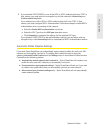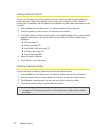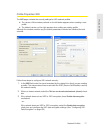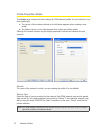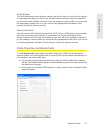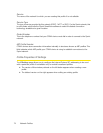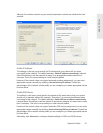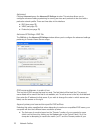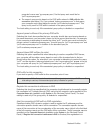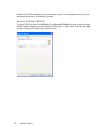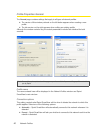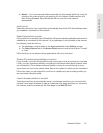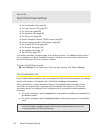
Network Profiles 77
Network Profiles
computer's name was “mycompany.com,” the first query sent would be for
“pc21.mycompany.com.”
● The
second query sent is based on the DNS suffix entered in DNS suffix for this
connection (see below). So, if you entered “sales.mycompany.com” in that space,
your computer would also attempt to resolve “pc21.sales.mycompany.com.” This
query is only sent if a DNS suffix is entered in the space provided.
The local setting is used only if the associated gr
oup policy is disabled or unspecified.
Append parent suffixes of the primary DNS suffix
Selecting this check box specifies that your computer should also send queries based on
the parent domains in your computer’s name (up to the second level domain). For example,
if your computer is attempting to resolve the name “pc21” and its own name includes the
domain named “us.sales.mycompany.com,” it would query for “pc21.mycompany.com” and
“pc21.sales.mycompany.com” in addition to the standard query for
“pc21.us.sales.mycompany.com.”
Append these DNS suffixes (in order)
Selecting this option specifies that when attempting to resolve unqualified DNS Names,
your computer will formulate a query based on each of the domains listed in the box
directly below this option. For example, if your computer is attempting to resolve the name
“pc21” and the domains “sales.mycompany.com” and “mycompany.com” appear in the list,
your computer will query for “pc21.sales.mycompany.com” and “pc21.mycompany.com.”
The local setting is used only if the associated gr
oup policy is disabled or unspecified.
DNS suffix for this connection
If you wish to specify a DNS suffix for this connection, enter it here.
Note: If you enter a DNS suffix here, it will override any suffix assigned dynamically by a DHCP server. The
local setting is used only if the associated group policy is disabled or ignored.
Register this connection’s addresses in DNS
Selecting this check box specifies that the computer should attempt to dynamically register
this connection’s IP Address (through DNS) using the full computer name specified on the
Computer Name tab (available under System in the Windows Control Panel). The local
setting is used only if the group policy is disabled or unspecified.
Use this connection’s DNS suffix in DNS registration
Specifies whether DNS dynamic update is used to register the IP addresses and the
connection-specific domain name of this connection. The connection-specific domain
name of this connection is the concatenation of the computer name (which is the first label
of the full computer name) and the DNS suffix of this connection. The full computer name is
specified on the
Computer Name tab (available under System in the Windows Control
Panel). If
Register this connection's addresses in DNS is checked, this registration is in



